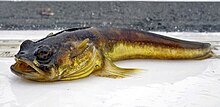Porichthys notatus
| Porichthys notatus | |
|---|---|
 |
|
| Scientific classification | |
| Kingdom: | Animalia |
| Phylum: | Chordata |
| Class: | Actinopterygii |
| Order: | Batrachoidiformes |
| Family: | Batrachoididae |
| Genus: | Porichthys |
| Species: | P. notatus |
| Binomial name | |
|
Porichthys notatus Girard, 1854 |
|
Porichthys notatus is a species of fish in the toadfish family. It is a midshipman known by the common name plainfin midshipman. It is native to the eastern Pacific Ocean, where its distribution extends along the coast from Sitka, Alaska, to Magdalena Bay in southern Baja California.
This fish reaches up to 38 cm (15 in) in length. It is brownish to olive to iridescent purple dorsally, becoming lighter on the sides and yellowish/golden on the belly. Below the eye is a whitish patch and black crescent. A young individual may have a dark saddle-mark. The fish has wide pectoral fins and a narrow but rounded tail fin.
Habitat types for this marine fish include intertidal zones, where it seeks cover under rocks and in patches of seaweed. It can also be found on the seabed in deeper water, sometimes over 300 m (1,000 ft).
The conditions of the intertidal habitat type change regularly with the tide. A fish sheltering among the rocks can become stranded as the tide recedes, even becoming beached completely out of the water. The fish tolerates this well. It can breathe air.Physiologically, it is well adapted to hypoxia, as well as hypercapnia. Even its sperm are quite functional in low-oxygen conditions.
Its diet includes crustaceans and fish. It is nocturnal, feeding at night and resting during the day, when it buries itself in the sand.
The fish is oviparous. The male claims a nest site, which is generally under a rock in the intertidal zone. Once the female spawns she leaves the eggs in the care of the male and departs. One female can lay about 400 eggs, but the male may mate with a few females and end up with over 1000 eggs in his nest. The eggs and larvae are adhered to the wall of the nest. The male tends them by fanning them, keeping the nest clean, and hydrating them if they begin to desiccate at low tide. He protects the larvae post-hatching until they reach their juvenile stage and leave the nest, about 45 days after fertilization. Very occasionally, an egg will yield twin larvae.
...
Wikipedia

